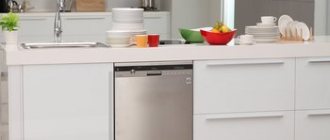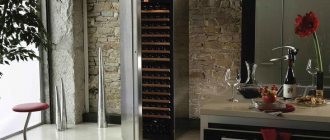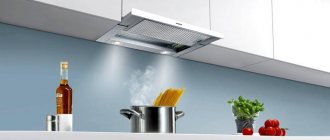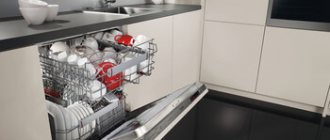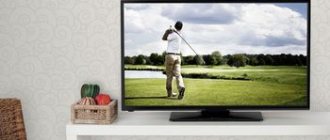In household appliance stores you can see similar devices of various types, but built-in devices are considered the most popular.
They can be hidden discreetly in the upper cabinet and will not disrupt the design of the kitchen, as well as save space.
In order for the hood to work well without failures, many parameters should be taken into account when choosing it.
We reviewed the best built-in kitchen hoods of 2021 in terms of price/quality ratio. The TOP is based on real consumer reviews and expert ratings. Among them, you will definitely choose a model that suits all parameters.
Rating of the TOP 20 best built-in hoods for the kitchen in 2021
| Place | Name | Price |
| TOP 4 best built-in kitchen hoods in price/quality ratio for 2021 | ||
| 1 | Faber Inca Plus HIP X A52 | Find out the price |
| 2 | ELIKOR Integra 60 black/black | Find out the price |
| 3 | LEX Hubble 600 Inox | Find out the price |
| 4 | Krona Kamilla 1M 500 white | Find out the price |
| TOP 4 best fully built-in kitchen hoods 60 cm | ||
| 1 | Krona Mini 600 white | Find out the price |
| 2 | Faber IN-NOVA PREMIUM X A60 | Find out the price |
| 3 | Krona Mini 600 inox | Find out the price |
| 4 | ELIKOR Integra 60 white/white | Find out the price |
| TOP 4 best built-in kitchen hoods 50 cm | ||
| 1 | ELIKOR Integra 50 white/white | Find out the price |
| 2 | Krona Kamilla 1M 500 black | Find out the price |
| 3 | ELIKOR Integra 50 black/stainless steel | Find out the price |
| 4 | GEFEST BO-4501 K20 | Find out the price |
| TOP 4 best built-in kitchen hoods 45 cm | ||
| 1 | ELIKOR Integra 45 black/black | Find out the price |
| 2 | ELIKOR Integra 45 white/stainless steel | Find out the price |
| 3 | Krona Kamilla 1M 450 inox | Find out the price |
| 4 | ELIKOR Integra 45 cream/cream | Find out the price |
| TOP 4 best built-in retractable hoods for the kitchen | ||
| 1 | Krona Kamilla 2M 600 black | Find out the price |
| 2 | ELIKOR Integra 60 black/stainless steel | Find out the price |
| 3 | Krona Kamilla 1M 600 black | Find out the price |
| 4 | Krona Kamilla Sensor 2M 600 inox/white glass | Find out the price |
Connection to communications
With duct
The presence of ductwork determines whether your hood functions as a hood or as a simple air purifier. The air can be discharged into ventilation or directly to the street. In this case, the air exchange is an order of magnitude higher, however, along with all the excess fumes from the kitchen, especially in winter, heat will also leave.
The smoother and more uniform the walls of the duct, the better it works.
Without duct
This hood works on the principle of air recirculation using filters. This ensures heat retention in the kitchen, but does not completely remove harmful fumes and excess moisture.
Which built-in hood to choose?
To choose the best hood in 2021, you need to pay attention to the following parameters:
- Filter . Almost all hoods have a grease filter. It protects the engine, fan and other parts of the grease extractor.
- Number of speeds . It is better to choose a device with a large number of speeds.
- Engines . Many hoods have one motor, which directly affects the suction power.
- Productivity . The most important parameter that determines whether the device will cope with the created steam.
- Power . It depends on the type of engine. The range of this parameter is presented from 100 to 290 W.
- Noise level . All models are characterized by high noise, but a level of up to 50 dB is considered optimal.
- Frame . All hoods are made of stainless steel. This is a durable material that ensures reliability and durability.
- Type of control . The device can be controlled mechanically and electronically. The first option is considered the best, since the electronic display may not work as well due to fat sticking to it.
- Lighting . The hood can be equipped with lamps that differ in power and brightness.
Types of hoods and their photos in the interior
The form factor has already been partially touched upon above, but given the huge variety of the model range, it is worth exploring this issue in more detail.
Traditional (classical)
In the interior of the kitchen, it is also called a fireplace hood (or dome), because its shape is very similar to the upper part of the fireplace.
It is often found in the classic style, since it was in this form that it was first presented. True, at the beginning there weren’t even fans in it, and the connection was made directly to the exhaust pipe of private houses.
Traditional form factor
"Island" hood options
As mentioned above, this type is installed above the island part of the kitchen unit.
Considering that hidden installation is impossible here, manufacturers began to offer various interesting form factors in the form of a cylinder, a ball, “flying saucers”, etc., as in the photo.
Traditional island hood
Built-in kitchen hood
Not all designers and customers like to see a hood, which usually does not harmonize with the kitchen set. So manufacturers began to offer mechanisms built into wall cabinets.
In terms of functionality, this option is practically in no way inferior to traditional form factors and even wins in terms of practicality in cleaning.
Built-in hood
Retractable hood
Almost the same as the option above. The only difference is that these models have an additional retractable element. Due to this, such a hood is partially visible from the facade.
The advantage of this model is that when the additional panel is pulled out, the fans turn on automatically. No buttons need to be pressed.
Retractable hood in the kitchen interior
Performance
For a favorable atmosphere, it is not enough to choose the correct dimensions of the equipment relative to the stove; you also need to decide on the performance.
This indicator is measured in m3/hour. When calculating, the kitchen area and ceiling height are taken into account. According to standards, the air should be renewed 10-12 times per hour. It is required to increase the resulting number by 20-30%: this is considered a power reserve.
So for a room of 12 square meters. m and a ceiling height of 2.7 m, a capacity of at least 500 m3/hour is required (12 x 2.7 x 12 x 1.3 = 505.44).
If you have a large space, then when calculating, you can take the value of 12-15 square meters. m, since evaporation usually does not spread beyond these limits.
To avoid having to make complex calculations yourself, see the table.
Pleasant moments of using such a device
This type of exhaust device is considered the most suitable for the kitchen.
Advantages:
- The retractable panel creates a larger field for air suction, so contaminated air will not leave the perimeter of the kitchen.
- The small size of the structure makes it easy to fit into a common kitchen set.
- High performance.
- The thin retractable bar will perfectly complement the decor of any kitchen.
- Simplicity of design, absence of unnecessary parts.
- Possibility of dual-mode operation.
- Additional lighting will appeal to lovers of late-night snacks.
- Simultaneous installation of a grease and carbon filter.
Telescopic models of exhaust hoods will not clutter up the kitchen environment, but, on the contrary, will complement the interior of a modern room.
Installation rules
Dimensions for retractable models are not the main criterion, since they are quite compact. Wall-mounted models are rarely installed openly; more often they are built into kitchen furniture. In an open installation, air ducts and electrical wiring are hidden in plasterboard boxes.
We recommend that you read: Construction and installation of ventilated facades made of porcelain stoneware
Safety standards require that the hood be installed no closer than 65 cm from gas burners. For an electric stove, this distance is reduced by 10 cm.
Air ducts for connecting the hood are purchased separately. Equipment manufacturers do not provide them. When installing air ducts, inclined sections and long horizontal hoses should be avoided. The larger the cross-section of the air channel, the more efficient and silent the operation of the device.
Air purification method
Modern hoods have two types of cleaning: exhaust and recirculation.
The exhaust involves removing air from the apartment through a ventilation duct. This method is considered more effective. However, the need to pull the air duct is very upsetting for many for aesthetic reasons.
Remember that every 90 degree rotation of the duct reduces efficiency by 5%.
To protect internal parts, the unit is equipped with a metal grease trap, where the bulk of the contaminants are deposited. It is removable and needs to be washed as it becomes salted.
It is very important to have an anti-return valve. It will prevent outside air from entering when the blower is turned off.
Recirculation devices drive the air through filters and return it cleaned to the room. This technique is suitable for those homes where connection to the ventilation duct is impossible for any reason.
Also, be prepared to incur additional costs for fairly frequent replacement of parts of such equipment. There are two stages of cleaning here.
- A mesh-shaped cassette for removing large oil particles and preventing them from getting inside. After a certain level of contamination, it must be replaced with a new one.
- The carbon filter captures unpleasant odors and must be replaced approximately every 4-6 months.
The display system will remind you of the need to install or wash filters. This may be a light indicator or a message on the display, and in some budget solutions, special symbols disappear on the purifier itself as the resource is used up.
There are devices that can operate in two modes. This is especially convenient in winter, when it is unprofitable to remove warm air from the apartment.
Number of speeds and motors
The number of speeds varies from 1 to 4. At each subsequent level, the cleansing is more intense, but the volume and power consumption increase.
Also, in some cases, a turbo mode is provided, which is activated only in emergency situations, when there is very strong contamination - for example, when something burned, there is smoke and the “aroma” of burning.
Most devices are equipped with one motor, but there are some with two. The second engine is connected when operating at high speeds. Together they allow you to cope with your task much faster, but, as a rule, they are more energy-intensive and noisy. The purchase of such equipment is advisable for spacious areas where there is a lot of frying and cooking.
Design features or what to pay attention to
Built-in hoods have virtually no effect on the design of the room, so perhaps the main argument when buying a new built-in hood is its dimensions. First, pay special attention to the size of the stove - the hood should not be smaller than the size of the hob!
If the size of the hood is slightly larger than the size of your stove, it’s okay; small deviations from the standard dimensions are acceptable and will not affect the operation of the system as a whole.
When purchasing a new built-in hood, pay special attention to those models that have coarse and fine filters. For your information, coarse filters are essentially grease traps. Their base is a mesh, which, if necessary, can be easily removed and washed with a regular cleaning agent.
Fine filters are designed to clean the air from harmful microelements and odors - they are mainly used in air recirculation mode, cleaning the room and at the same time keeping it warm. Quite often, carbon filters are not included in the standard assembly of built-in hoods, so carbon filter elements must be purchased separately.
Many modern hoods have a speed setting.
Please note!!! The more speeds the hood has, the faster the fan rotates and, accordingly, the noise level increases. You should not take super strong units - a range hood with an 8-speed mode can satisfy the needs of even a small culinary workshop and will be a completely acceptable option for an ordinary kitchen.
In addition to speeds, hoods can have either one or two fans. But keep in mind that two small fans are much quieter than one large one.
The best retractable
Three hoods are offered that are considered the most effective. The equipment has positive reviews, quality certificates and licenses. This link will tell you how to choose the right knives for the kitchen.
Hansa OKC 6726 IH
The device is distinguished by its original design and reasonable cost. Other characteristics.
- Width – 43 cm, height – 143 cm, depth – 47 cm.
- Power – 160 W.
- Air channel diameter – 150.
- Operating mode – drainage/circulation.
- Productivity m3/h (maximum) – 620.
- Control type – electronic.
- Speeds – 4 pcs.
- Noise – 69 dB.
- Lighting – halogen (can replace lighting).
- The filter is grease.
The cost of the model is 12,900 rubles.
Disadvantages: the lamps can get very hot, the touch buttons are poorly lit and are sometimes glitchy.
Kronasteel LINA 600 white 4P-S
The cost of the model is slightly higher than average, but the buyer receives a reliable, quiet and productive device. Reviews about this hood are only positive.
- Width – 60 cm, height – 133.2 cm, depth – 43.6 cm.
- Power, W – 198.
- Air duct diameter – 150.
- Operating mode – drainage/circulation.
- Productivity, m3/h – 800.
- Control type – electronic.
- Speeds – 4 pcs.
- Noise – 40 dB.
- Lighting – LED.
- The filter is grease.
You can install a carbon filter and use recirculation. Speed 1 and 2 are sufficient for cooking. The disadvantages include the presence of an additional transformer for lighting, which will take time to replace if it breaks, and the power cord is too tightly clamped by the protective casing during installation. This material will tell you which laminate flooring is best for the kitchen.
MAUNFELD Tower C 60
The device is recommended for kitchens up to 20 m2. Undemanding and stylish, the work surface is made of glass, located at an angle, which is convenient, there is additional lighting above the cooking area, and there is a check valve.
Cost – 9700 rub.
- Width – 50 cm, height – 92 cm, depth – 31 cm.
- Power, W – 250.
- Air duct diameter – 120.
- Operating mode – drainage/circulation.
- Capacity – 520 m3/h.
- Electronic control
- 3 speeds.
- Noise – 54 dB.
- Halogen lamps.
- Filter type: grease filter.
Disadvantages: it is inconvenient to look at the control buttons if you place the hood at a distance of 45 cm (according to the instructions), the slightest dirt is visible on the black surface, it makes a lot of noise at speed 3.
Dimensions
The value should be selected based on the dimensions of the hob. It is the width that determines how well the fumes generated from cooking will be captured.
The dimensions of the hood should be slightly larger than the dimensions of the panel. On the market you can find devices with a width of 50 to 90 cm. Models with a side of 60 cm are standard and universal. They are suitable for most gas stoves and electric surfaces.
The depth depends on the parameters of the furniture in which the device is mounted. There are several solutions.
- Narrow appliances with a retractable panel that increases coverage area.
- The device is equal in depth to the headset.
- An option with a depth less than that of a cabinet.
In kitchens where cooking is frequent and varied, the use of the first group of devices is more appropriate. But the second and third types are more appropriate if the process of cooking occurs periodically.
If you install a copy that is smaller than necessary, then you will face negative consequences:
- the unit will not cope 100% with its task, and some of the odors and fumes will enter the living rooms;
- Oily deposits and moisture will settle on nearby walls, which can cause the furniture to change color and swell.


